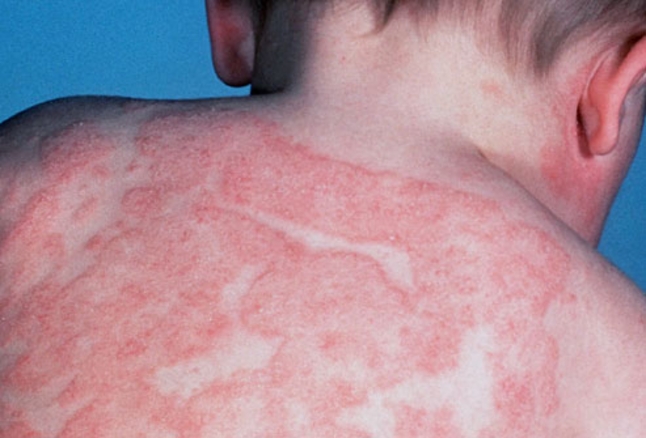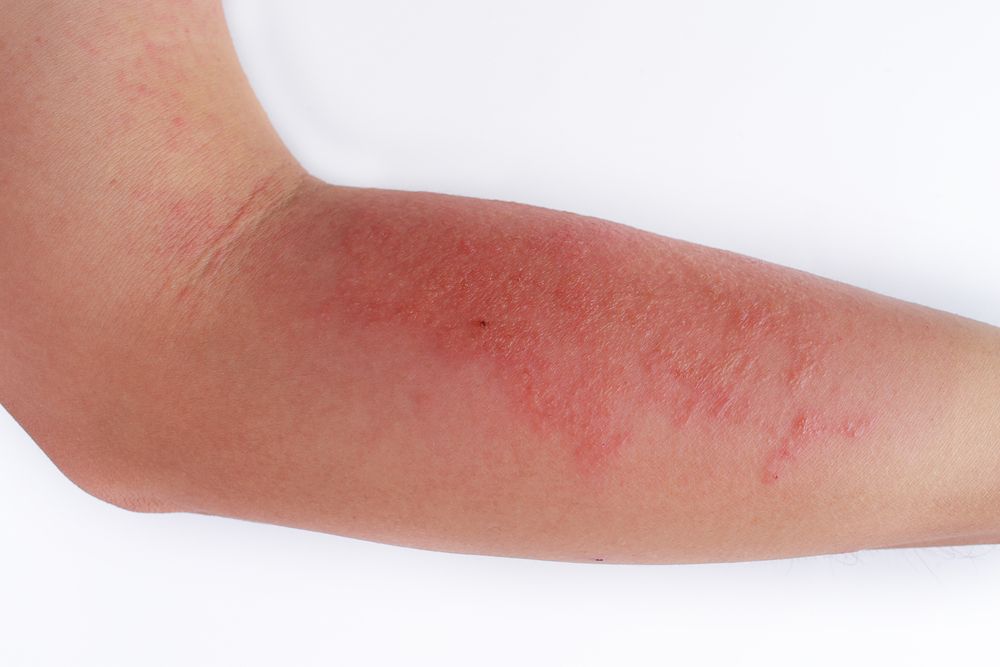Atopic Dermatitis | Symptoms | Causes | Prevention | Treatment | Side Effects | Quality of Life |
Atopic dermatitis is a chronic skin condition that causes dry, itchy skin. Usually, atopic dermatitis begins in the first six months of a baby’s life. It may continue into adulthood, occurring at any age. In both children and adults, the condition may be limited or widespread.
Atopic dermatitis is the most common and severe form of eczema. Often, there are periods of time when it flares followed by periods of time when the skin improves.
Atopic dermatitis is a complex disease and there is currently no known cure. It is not contagious and cannot spread from person to person. Atopic dermatitis affects both males and females equally and is increasing in prevalence worldwide.

Atopic dermatitis causes dry skin and small, red, itchy bumps. These bumps can be filled with pus may leak when they are scratched. The condition can exacerbate to scaling, oozing skin and may even lead to skin infections.
In both children and adults, this skin condition presents red, itchy rashes. These rashes occur on the back of the neck, the back of the knees, and in elbow creases.
In children, atopic dermatitis may first present as a rash on the cheeks, the chin and scalp. In toddlers, it generally affects the outer surfaces of the wrists, elbows, ankles, and knees. As children grow older, the condition affects the creases in the knees and elbows. Many children also develop small coin-shaped areas of atopic dermatitis over their body. Children may also have scratch marks made by their sharp nails. Vigorous scratching can make their skin look raw.
A red, itchy rash is the typical symptom of an atopic dermatitis flare up. Often the rash becomes hard and scaly when scratched repeatedly. The rashes can also weep and even bleed when scratched leading to infection. Scratching also makes the skin chafed and thick.
Dry skin is a common complaint in people with atopic dermatitis. This may affect the skin around the eyes, the eyelids, and eyebrows. It can also affect the skin around the lips leading to painful cracks.
Atopic dermatitis can present in three clinical phases, acute, subacute, and chronic. Most people may have acute flare ups and experience inflamed, blistered, and weepy patches on their skin.
Atopic dermatitis causes an agonizing itch-scratch cycle. Dry skin can make the itching worse and the scratching itself can cause more irritation. People with atopic dermatitis may be more sensitive to itching. They may need to scratch an itchy patch longer. This itchiness is often severe at night and can affect sleep quality. Poor sleep in turn impacts the quality of life for the entire family. In adults and caregivers, work performance can be affected as well.

The exact cause of atopic dermatitis is not known.
In people with atopic dermatitis the immune system becomes disordered and overactive. This triggers inflammation that damages the skin barrier. The damaged skin barrier results in contact between immune cells in the dermis and antigens from the outside environment.
The inflammation also causes increased blood flow and results in an urge to itch. Scratching or rubbing the itchy areas can in turn worsen this skin inflammation causing an itch-scratch cycle.
A genetic component is thought to play a role in atopic dermatitis. A genetic defect in the filaggrin protein causes atopic dermatitis by disrupting the skin. Filaggrin is a protein which helps maintain a healthy, protective barrier on the top layer of the epidermis. It also helps in retaining the skin’s moisture levels. People with atopic dermatitis may have a defective form of filaggrin or a decreased levels of it.
A family history of atopy is a risk factor for atopic dermatitis. Atopy is a medical syndrome. It causes the development of three linked conditions: atopic dermatitis, asthma, and hay fever. Children with atopic dermatitis often have someone in their family who has hay fever or asthma.
More than half of the children with atopic dermatitis go on to develop asthma or hay fever themselves. Another potential cause of atopic dermatitis may be the level of calcium carbonate in household water or its hardness.
Atopic dermatitis is a chronic skin condition that often flares periodically. Environmental factors can cause atopic dermatitis to flare up at any time. Identifying and avoiding triggers that exacerbate the condition can help relieve symptoms.
Self-care routines and lifestyle changes that keep your skin calm help to prevent scratching. These routines can also lengthen the time between flare ups.
Create and follow a skin care routine that works for you. Take care of your skin by moisturizing at least twice daily with thick creams or emollients. These generally have a low water content. This improves the skin barrier. Avoid using harsh soaps, detergents, and cleansers. Deodorants and antibacterial soaps can dry skin out. They may also be triggers for atopic dermatitis flare ups.
Take shorter showers and baths with warm water instead of hot water. Pat yourself dry carefully afterwards. Daily baths and showers remove bacteria and reduce the chances of skin infections. Warm oatmeal baths may also help. The antioxidants in oatmeal may ease itching and inflammation.
A bath with a small amount of household bleach may help to cleanse and disinfect the skin. It may also improve skin rash and decrease the need for antibiotics. Use a half-cup of bleach for a 151-litre tub of lukewarm water. Do not submerge your head in the water and do not take a bleach bath more than once a week.
Choose loose clothing made from soft cotton. Avoid certain fabrics and materials, such as wool, if they trigger flare ups. Cold weather and low humidity can increase the chances of a flare up. Use a humidifier to reduce dryness. Avoid extreme temperatures, both hot and cold.
Use distractions to minimize itching in children whenever possible. Put gloves on children at night to reduce itching and scratches. Apply pressure on itchy parts of your skin instead of scratching. Keep nails trimmed to prevent scratches from sharp nails, particularly in children.
Sleep disturbances, scars, and skin atrophy are some of the complications of atopic dermatitis. Several types of treatments are available for atopic dermatitis. These range from over the counter skin care, lifestyle changes to prescription medication.
If these treatments are not effective, doctors may prescribe systemic corticosteroids. These can be taken orally or injected into muscles. Immunosuppressive drugs may be used in adults to treat severe cases of atopic dermatitis. In rare cases, hospitalization may be required.
Some of the treatments available for atopic dermatitis present significant side effects.
The long term use of topical corticosteroids can result in growth retardation in children. Systemic corticosteroids come with side effects such as skin damage, weakened bones, and high blood pressure. Other side effects include high blood sugar, cataracts, and infections.
The side effects of immunosuppressive drugs are high blood pressure, nausea, and vomiting. There is also an increased risk of cancer. Topical calcineurin inhibitors can cause skin burning and irritation.
The long-term side effects of photochemotherapy include skin aging and skin cancer.
Discuss any concerns about side effects with your healthcare practitioner. The goal of a treatment plan is to manage the symptoms of atopic dermatitis and improve the quality of life. Communicate with your healthcare team to curate a treatment plan that works for you.
In the case of children with atopic dermatitis, the quality of life of the entire family may be affected. Children with atopic dermatitis may need extra support and encouragement from their family.
Both patients and their families should learn the signs of atopic dermatitis flare ups and any skin infections. This can add to the stress and frustration caused by the condition. Lack of sleep due to scratching can lead to drowsiness in the patient and their caregivers, further affecting quality of life.
In some instances, atopic dermatitis may cause disfigurement. This can lead to social and emotional stress for the family.
Atopic dermatitis can affect a patient’s quality of life into adulthood as well. Some occupations, such as industrial cleaning and hairdressing, expose the skin to irritants. This can cause flare ups through the work environment. Education and awareness about atopic dermatitis play an essential role in managing this condition.
There are several options for managing the symptoms of atopic dermatitis. Discussions with healthcare practitioners should guide treatment plans. Self-care routines can also help reduce flare-ups and have a positive effect on quality of life.
“Atopic Dermatitis”
“Atopic Dermatitis”
“What is Atopic Dermatitis?”
“Atopic Dermatitis Symptoms, Causes, vs. Eczema, Remedies, and Treatment”